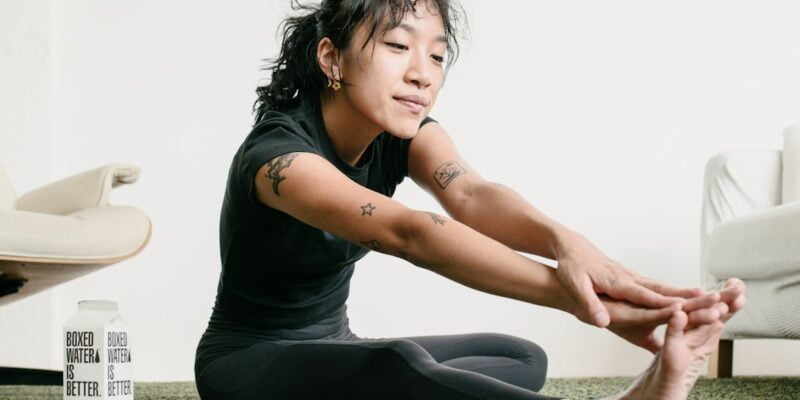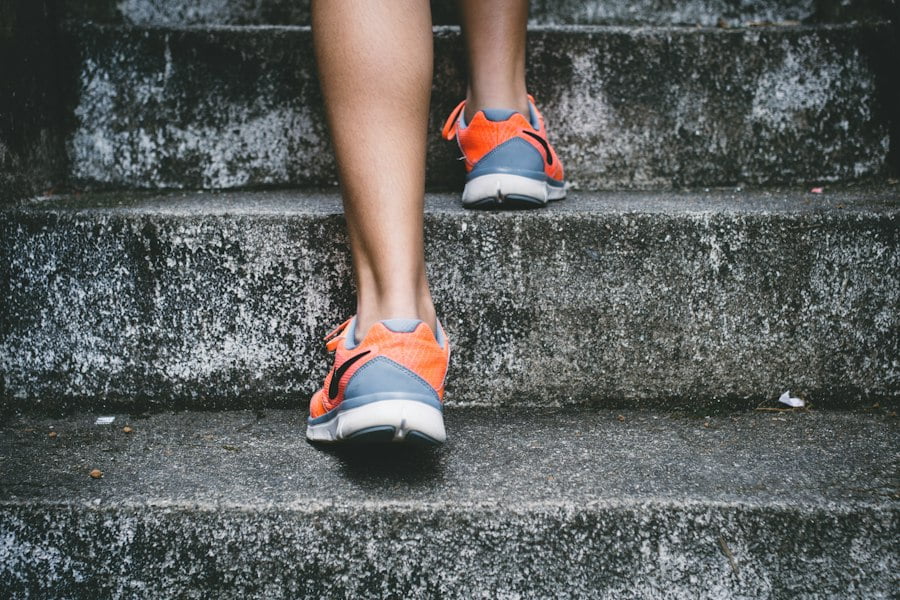
Quick exercises to do during breaks
In today’s fast-paced world, it can be easy to get caught up in the demands of work and neglect our physical health. However, taking breaks and incorporating exercise into our daily routine is crucial for our overall well-being and productivity. Exercise during breaks not only helps to combat the negative effects of sitting for long periods of time, but it also improves focus, energy, and mood. In this article, we will explore the importance of exercise during breaks and provide examples of different exercises that can be done in a small space or at a desk.
Key Takeaways
- Taking breaks to exercise is important for overall health and productivity.
- Stretching exercises can help improve flexibility and prevent injury.
- Cardiovascular exercises can improve heart health and boost energy levels.
- Strength training exercises can help build muscle and improve posture.
- Yoga, Pilates, desk exercises, breathing exercises, and meditation can all be incorporated into breaks for added benefits.
The Importance of Exercise During Breaks
Sitting for long periods of time has been linked to a number of health issues, including obesity, heart disease, and diabetes. When we sit for extended periods, our muscles become inactive, leading to decreased blood flow and metabolism. This can result in weight gain, muscle loss, and a decrease in overall energy levels.
Exercise during breaks can help counteract these negative effects by increasing blood flow and metabolism. When we engage in physical activity, our heart rate increases, delivering more oxygen and nutrients to our muscles and organs. This increased blood flow not only improves our physical health but also enhances our cognitive function.
Research has shown that exercise during breaks can improve focus, memory, and overall cognitive performance. When we exercise, our brain releases endorphins, which are chemicals that boost mood and reduce stress. This can lead to increased productivity and creativity in the workplace.
Stretching Exercises
Stretching is an important component of any exercise routine as it helps to improve flexibility and prevent injury. Stretching during breaks can help alleviate muscle tension and stiffness that may occur from sitting for long periods.
There are several stretching exercises that can be done at a desk or in a small space. One example is the seated forward bend stretch. To do this stretch, sit on the edge of your chair with your feet flat on the floor. Slowly bend forward from your hips, reaching your hands towards your feet. Hold this stretch for 30 seconds and then slowly return to an upright position.
Another stretching exercise that can be done at a desk is the shoulder stretch. Stand up and place your right arm across your chest, using your left hand to hold it in place. Hold this stretch for 30 seconds and then switch sides.
When performing stretching exercises, it is important to maintain proper form and technique. Avoid bouncing or jerking movements, as this can lead to injury. Instead, focus on slow, controlled movements and breathe deeply throughout each stretch.
Cardiovascular Exercises
Cardiovascular exercise is essential for maintaining a healthy heart and improving overall cardiovascular health. Incorporating cardiovascular exercises into your breaks can help increase energy levels and improve mood.
There are many cardiovascular exercises that can be done in a small space or outside. One example is jumping jacks. To do jumping jacks, start with your feet together and your arms by your sides. Jump up, spreading your feet wider than hip-width apart and raising your arms above your head. Jump back to the starting position and repeat for 1 minute.
Another cardiovascular exercise that can be done in a small space is high knees. Stand with your feet hip-width apart and lift one knee up towards your chest while hopping on the other foot. Alternate legs and continue for 1 minute.
When performing cardiovascular exercises, it is important to maintain proper form and technique. Keep your core engaged and land softly on the balls of your feet to minimize impact on your joints. If you have any pre-existing health conditions or injuries, consult with a healthcare professional before starting a new exercise routine.
Strength Training Exercises
Strength training is important for building muscle mass, increasing bone density, and improving overall strength and stability. Incorporating strength training exercises into your breaks can help prevent muscle loss and improve overall physical performance.
There are many strength training exercises that can be done with minimal equipment. One example is the bodyweight squat. Stand with your feet shoulder-width apart and lower your body down into a squat position, keeping your knees behind your toes. Push through your heels to return to the starting position and repeat for 10-12 repetitions.
Another strength training exercise that can be done with minimal equipment is the push-up. Start in a plank position with your hands slightly wider than shoulder-width apart. Lower your body down towards the floor, keeping your elbows close to your sides. Push through your palms to return to the starting position and repeat for 10-12 repetitions.
When performing strength training exercises, it is important to maintain proper form and technique. Keep your core engaged and breathe deeply throughout each exercise. Start with lighter weights or modifications if necessary and gradually increase the intensity as you become stronger.
Yoga and Pilates Exercises

Yoga and Pilates are both excellent forms of exercise that can be done in a small space or at a desk. These exercises focus on improving flexibility, strength, and balance, while also promoting relaxation and stress reduction.
There are many yoga and Pilates exercises that can be done in a small space. One example is the seated spinal twist. Sit on the edge of your chair with your feet flat on the floor. Place your right hand on the back of the chair and twist your torso to the right, looking over your right shoulder. Hold this stretch for 30 seconds and then switch sides.
Another yoga exercise that can be done in a small space is the downward dog pose. Start on all fours with your hands shoulder-width apart and your knees hip-width apart. Lift your hips up towards the ceiling, straightening your legs as much as possible. Press through your palms and heels to lengthen your spine and engage your core. Hold this pose for 30 seconds.
When performing yoga and Pilates exercises, it is important to maintain proper form and technique. Focus on your breath and listen to your body. If a pose feels uncomfortable or painful, modify or skip it altogether. It is always best to practice under the guidance of a qualified instructor, especially if you are new to these exercises.
Desk Exercises
Desk exercises are a great way to incorporate movement into your breaks, especially if you have limited space or are unable to leave your desk. These exercises can be done while sitting or standing and can help alleviate muscle tension and improve circulation.
There are many desk exercises that can be done while sitting or standing at a desk. One example is the seated leg lift. Sit on the edge of your chair with your feet flat on the floor. Lift one leg up towards your chest, keeping your knee bent. Lower your leg back down and repeat on the other side. Continue alternating legs for 1 minute.
Another desk exercise that can be done while sitting is the shoulder roll. Sit up tall with your feet flat on the floor and roll your shoulders forward in a circular motion. Repeat this motion for 1 minute and then reverse the direction.
When performing desk exercises, it is important to maintain proper form and technique. Sit up tall with your shoulders back and down, and engage your core throughout each exercise. Take breaks as needed and listen to your body.
Breathing Exercises
Breathing exercises are a simple yet effective way to reduce stress, increase relaxation, and improve focus. Incorporating breathing exercises into your breaks can help calm the mind and promote a sense of well-being.
There are many breathing exercises that can be done in a small space or outside. One example is deep belly breathing. Sit or stand up tall with your feet flat on the floor. Place one hand on your belly and take a deep breath in through your nose, allowing your belly to rise as you fill your lungs with air. Exhale slowly through your mouth, allowing your belly to fall. Repeat this deep belly breathing for 1-2 minutes.
Another breathing exercise that can be done in a small space is alternate nostril breathing. Sit up tall with your feet flat on the floor and close your eyes. Use your right thumb to close your right nostril and inhale deeply through your left nostril. Use your right ring finger to close your left nostril and exhale through your right nostril. Inhale through your right nostril, close it with your thumb, and exhale through your left nostril. Continue alternating nostrils for 1-2 minutes.
When performing breathing exercises, it is important to focus on slow, deep breaths and to breathe from the diaphragm rather than shallow chest breaths. Take breaks as needed and listen to your body.
Meditation Exercises
Meditation is a practice that involves focusing the mind and achieving a state of calm and relaxation. Incorporating meditation exercises into your breaks can help reduce stress, improve focus, and increase overall well-being.
There are many meditation exercises that can be done in a small space or outside. One example is mindfulness meditation. Find a quiet space where you can sit comfortably with your eyes closed. Focus on your breath, noticing the sensation of each inhale and exhale. If thoughts or distractions arise, simply acknowledge them and return your attention to your breath. Start with 5 minutes of mindfulness meditation and gradually increase the duration as you become more comfortable.
Another meditation exercise that can be done in a small space is guided visualization. Find a quiet space where you can sit comfortably with your eyes closed. Imagine yourself in a peaceful and relaxing environment, such as a beach or forest. Visualize the sights, sounds, and smells of this environment, allowing yourself to fully immerse in the experience. Start with 5 minutes of guided visualization and gradually increase the duration as you become more comfortable.
When practicing meditation exercises, it is important to find a quiet and comfortable space where you can fully relax. Start with shorter durations and gradually increase the time as you become more experienced. If you find it difficult to quiet your mind, try using a guided meditation app or recording to help guide your practice.
Tips for Incorporating Exercise into Your Breaks
Incorporating exercise into your breaks can be challenging, especially if you have a busy schedule or are working in a sedentary job. However, with some planning and commitment, it is possible to make exercise a regular part of your daily routine.
One tip for incorporating exercise into your breaks is to schedule them in advance. Set aside specific times throughout the day for breaks and stick to them as much as possible. This will help create a routine and make it easier to prioritize exercise.
Another tip is to start small and gradually increase the duration and intensity of your exercise breaks. Begin with short breaks of 5-10 minutes and gradually work your way up to longer breaks of 15-30 minutes. This will help prevent burnout and make it easier to stick with your routine.
Tracking your progress can also be helpful in staying motivated and accountable. Keep a journal or use a fitness app to record your exercise breaks and track your progress over time. Celebrate your achievements and use them as motivation to continue incorporating exercise into your breaks.
In conclusion, exercise during breaks is crucial for our overall health and productivity. Sitting for long periods of time can have negative effects on our physical health and cognitive function. However, by incorporating stretching exercises, cardiovascular exercises, strength training exercises, yoga and Pilates exercises, desk exercises, breathing exercises, and meditation exercises into our breaks, we can improve our focus, energy, mood, and overall well-being. It is important to schedule breaks, stick to a routine, and track our progress to stay motivated and accountable. So, let’s make exercise a priority during our breaks and reap the benefits for our mind and body.
FAQs
What are quick exercises?
Quick exercises are short physical activities that can be done in a few minutes to improve physical fitness, increase energy levels, and reduce stress.
Why should I do quick exercises during breaks?
Quick exercises during breaks can help improve productivity, reduce stress, and increase energy levels. They can also help prevent health problems associated with prolonged sitting.
What are some examples of quick exercises?
Examples of quick exercises include stretching, walking, jumping jacks, squats, lunges, push-ups, and planks.
How long should I do quick exercises during breaks?
Quick exercises during breaks should be done for a few minutes, typically 5-10 minutes. It is important to listen to your body and not overdo it.
Can quick exercises be done in an office setting?
Yes, quick exercises can be done in an office setting. Examples include standing up and stretching, walking around the office, or doing squats or lunges in a private area.
Are there any risks associated with doing quick exercises during breaks?
There are minimal risks associated with doing quick exercises during breaks. However, it is important to listen to your body and not overdo it. If you have any health concerns, it is recommended to consult with a healthcare professional before starting any exercise routine.















